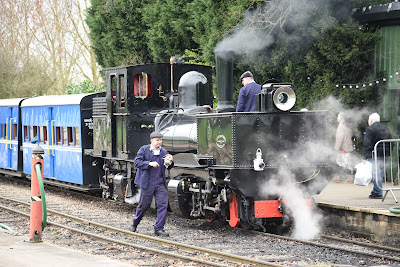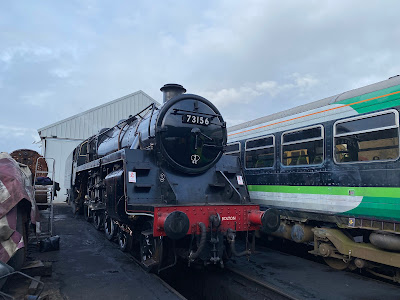Some days are good, some days are bad and some days start bad but get better: today was one of the latter days! This morning I was booked for a 05:15 sign on at Loughborough shed, ready to work the E1 turn with driver Alan. Early but certainly not bright, I arrived a little after 05:00, discovering the rostered S1 locomotive: BR Standard 2 No78019: simmering on No1 shed road under a clear morning sky...
Having signed in and read the notices, I clambered up into the cab of the Standard 2 in order to check everything out. The 2-6-0 was still stinking red hot, having not really been long on shed as she had worked the night diner the previous evening. The crew therefore wouldn't have got back onto shed before 22:00, explaining the full pot of water and steam still on the gauge. All seemed well up to now...
This is where things started to go a little south for me. Opening up the fire hole door, I had a look across the fire bed and it looked pretty much ready to drop. It wasn't thick by any means to look at but, alas, upon opening the catches for the rocking grate, I went to push forward and hit a solid mass. With no luck pushing forwards, I pulled back...solid. The grate was locked up. I put the catches back in and began working the top of the bars with an iron, breaking up the remaining embers. Fire bed loosened, I tried again (in vain I might add) to free the grate. Nope...solid! At this point I was faced with the inevitable: I had to go in. It's never a nice job this one, but especially not before 05:30 of a morning! If you want to go out though, you have no choice really.
Clambering into the hot firebox with my torch and brush, I found that the grate was solid with clinker. It was nothing to do with the way the engine was left (or in fact the crew on it), more down to the poor quality of coal we've had in recent months. (You can't even blame the coal quality on anybody as you need to take what you can get these days as coal isn't exactly easy to come by anymore!). The fire bed was thin and well run down but it seemed that what was left had melted itself across the bars, fusing the grate into its locked position. The Standard 2s don't have a carrier at the front either, so the rocking grate opens against the front tubeplate. This means that if ash or clinker congregates there and prevents the grate from opening, you're stuck really. A good bash with the brush followed by a thorough sweeping soon revealed the fire bars and the grate was freed up. I then clambered back out of the firebox, falling onto the footplate as an ash-covered, sweaty mess. The grate was then rocked, leaving a lovely clean finish fit for lighting up. The footplate would later be swept up.
Whilst I continued preparing for our new fire, driver Alan was making his way around the mogul with the oil cans. Firebox sorted, I turned my attention to the smokebox. Usually this is a fairly quick affair with a Standard, particularly with one fitted with a full self cleaner (as 78019 is). However, today had other ideas. In the end, a full wheelbarrow of ash was removed from the smokebox, with the accumulated char revealed to have climbed its way up several inches of the smokebox door when I opened it. That's unheard of with a self cleaner in my limited experience. Again, I put it down to the coal. Smokebox done, I had a sweep around the door ring and closed it up in readiness for lighting. Just as I prepared to light up, I grabbed the rushed snap below. The clinker removed from the bars via the firebox doors is seen at the bottom of the cab steps, topping the wheelbarrow full of smokebox char removed. "Phew!"...
"A good morning's work"
Over an hour after climbing onto the footplate, I finally had a fire bed fit for lighting up on. The first lit rag, wrapped around a piece of pallet wood, was soon being tossed into the firebox to start our embryo fire. We could now breathe a sigh of relief...
Finally, under promising blue skies, a plume of encouraging smoke was seen rising steadily upwards from 78019's chimney...
It was at this point (just when I needed it) that Alan suggested that we grabbed a very welcome cuppa'. (I didn't take any persuading let me tell you). Brew supped, the rest of the morning was spent finishing the preparation of the engine by doing things like emptying the ashpan. The final job, once washed and changed, was to grab some coal via the loader. Here, Tom skillfully puts a few buckets into the tender...
Once coaled, Alan checked in with the signalman to get permission for us to leave shed in readiness to work our first train: the 09:15. (The timetable saw an earlier train than usual due to the Bank Holiday weekend). Having left shed and taken water, 78019 is seen simmering at the head of the five-coach train...
With more than 15 minutes to go until departure, I could make up the fire steadily, watching the smoke all of the time. This coal, though it burns away quickly, is good in almost every regard except for the smoke. However, with the loss of Ffos-y-fran, preserved lines are finding that they are having to burn smokier foreign imports in order to survive. The far less smoky (and on the doorstep) Welsh coal is now impossible to get hold of. Leaving Loughborough on time, a still 'cold' (they're still cold even at full pressure on the first run) 78019 took a little bit of warming up but, by Kinchley Lane on the first outward trip, she was back in fettle and steaming nicely. At Leicester North (on both of our two rostered trips today) we were booked the extra time for footplate visits. 78019 is seen offering cab visits during our first run round...
Checking back through my blog records confirmed that this was only the second time I'd been on 78019, having spent more time on the sister 78018. The last time I crewed her was as a third man, whilst the Kylchap was still fitted in the smokebox. This has since been removed and, as far as I remember, its removal hasn't affected the steaming capabilities of the engine. In fact, she sounds far healthier at the exhaust. Our second trip was much like the first, although we were joined by GCR cleaner (and SBR apprentice) Stephen on our second trip. Once back at Loughborough after our second outing, we handed over the engine to incoming crew Matt and Dave...
Well, that's another turn complete at the GCR. I must thank Alan for his company this morning aboard 1954-built No78019: it was a pleasure to spend the morning with him. This was definitely a day that started badly and then got better. I know we joke and we moan but we wouldn't do these things if we didn't enjoy it. The hard work and early starts are all part and parcel of this hobby and you can only get out what you put in. Thanks all for reading. Roll on the next turn...
Please note any views or opinions expressed in this blog are merely personal and do not in any way represent the views or opinions of any other person, group or organisation.




































